Each week we feature a few artists from Art in Odd Places 2018: BODY NYC.
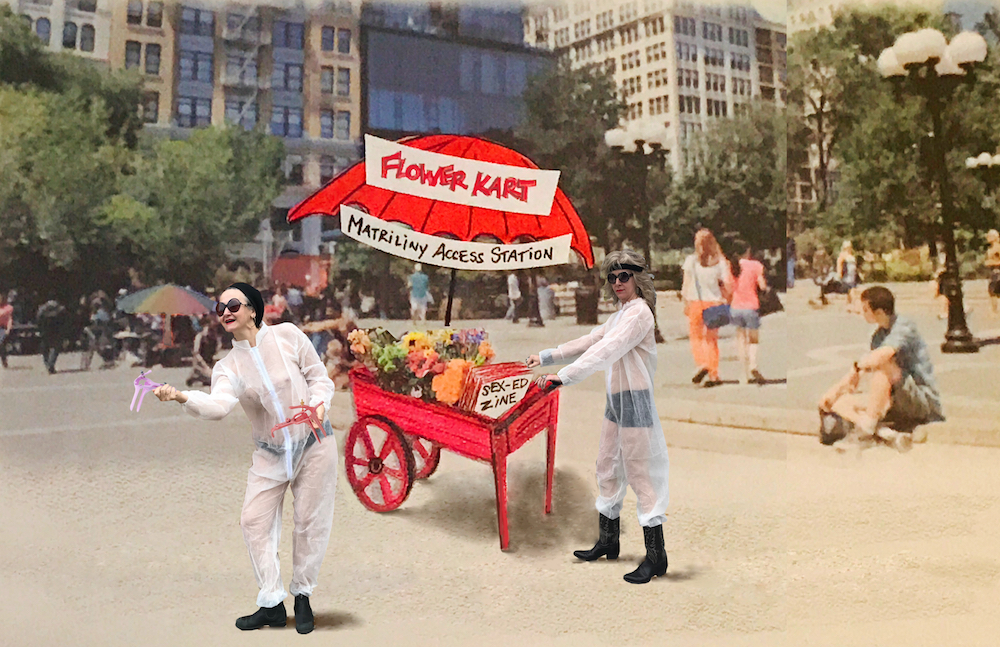
This Is Flower Kart #1: A Matriliny Access Station for Un-Patriation and Re-Distribution of Information, Knowledge, and Supplies, toward Re-Possession of Our Bodies, 2018. Photo Credit: Christen Clifford and Amy Finkbeiner
Christen Clifford and Amy Finkbeiner: The No Wave Performance Task Force
1. Tell us about yourself and your project for AiOP BODY 2018:
Christen Clifford is a feminist performance artist, writer, mother, and filmmaker, supported by IFP and Women in Film. She has shown work at Panoply Performance Lab, Dixon Place, and The New Museum. She has written for Broadly, The Guardian, and The Huffington Post. She teaches at The New School.
Amy Finkbeiner is a multidisciplinary artist whose work explores sexuality, religion, and identity. She recently presented work at ITINERANT Performance Art Festival, and at A.I.R. Gallery, Panoply Performance Lab, LaMama Galleria, Abrons Arts Center, Smack Mellon, and many other venues in the US and internationally.
The No Wave Performance Task Force enables performative social sculpture and practices feminist construction. Flower Kart: Matriliny Access Station is a NWPTF project organized by lead artists Christen Clifford and Amy Finkbeiner that seeks to share knowledge by giving flowers, zines, and speculums, among other materials, to all humans who need them.
2. What does the theme BODY mean to you?
We refer to something Clifford wrote in 2013: “There is no equality without reproductive rights, there are no reproductive rights without respect for the female body, there is no respect for the female body without knowledge of blood.”
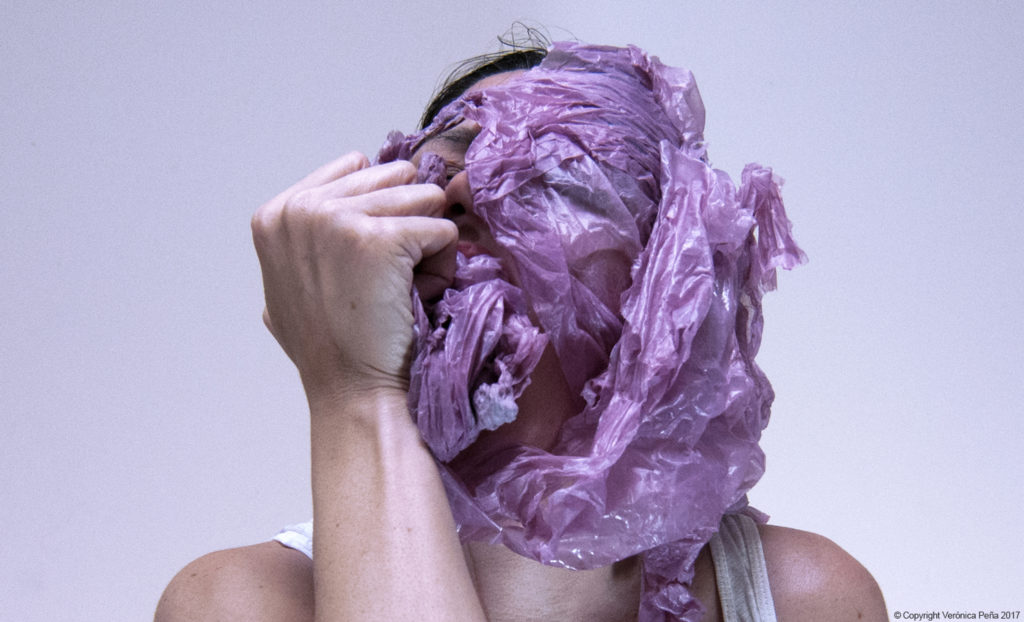
Verónica Peña, Retos (Challeges), 2017. Photo Credit: Verónica Peña
Verónica Peña
1. Tell us about yourself and your project for AiOP BODY 2018:
VERONICA PEÑA is an interdisciplinary artist from Spain based in the United States. Her work explores the themes of absence, separation, and the search for harmony through Performance Art. Peña is interested in migration policies, cross-cultural dialogue, liberation, and women’s empowerment. She is a recipient of the Franklin Furnace Fund 2017-18. Her project, “A MATTER OF…”, consists of a durational performance that involves a process of metamorphosis of the body, and seeks to generate dialog and shared moments amongst strangers in the street. Motivated by a search of ambiguity (the ambiguous body), and following a desire to contemplate the body as a physical and emotional matter beyond established categorizations, such as, gender, identity, race, etc.; “A Matter Of…” proposes the use of a malleable material to transform the body, explore new physicalities and potential understandings of the self, and promote empathy. Health, burden liberation, protection, care, vulnerability, and self empowerment are themes central to her project.
2. What does the theme BODY mean to you?
Human unity is at the basis of my practice. The BODY is a bond that we all share. As a performance artist, my body is my way of existing, a tool of freedom and communication. I am interested in how belief, illness, habits, and living conditions deform our bodies. I am in search of new embodiments, “ambiguous selves” in pursuit of liberation, bodies trying to express what is latent inside and hard to categorize.
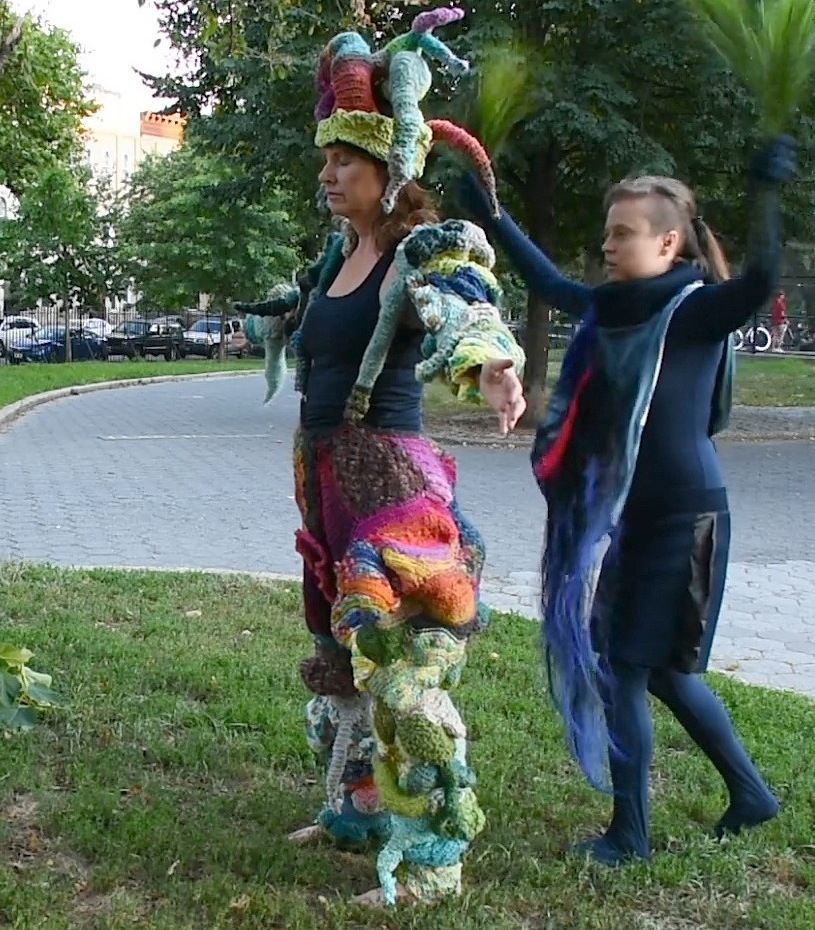
Donna Cleary and Kathie Halfin, Hell Hath No Fury, 2018. Photo credit: Donna Cleary
Donna Cleary and Kathie Halfin
1. Tell us about yourself and your project for AiOP BODY 2018:
We will embody the powerful Indian and Irish Goddesses Kali and Caillech during Art In Odd Places. Known for their expressions of rage, embodiment of these Goddesses is an appropriate response to our current political environment. Rage is a necessary release of emotions. It is loud and disruptive. But rage is not the end game. It is a catalyst for change. We will walk along 14th Street as powerful Feminine Deities performing both choreographed movements and healing ceremonies, interacting with viewers and each other.
2. What does the theme BODY mean to you?
The body is the site of care, resistance and change. The locus of our inner Goddess-Warrior, we believe that our embodied way of being structures our consciousness and subjectivity. We draw on ancient ways of thinking/being, the sacred feminine and enact rituals that heal past and recurring trauma.
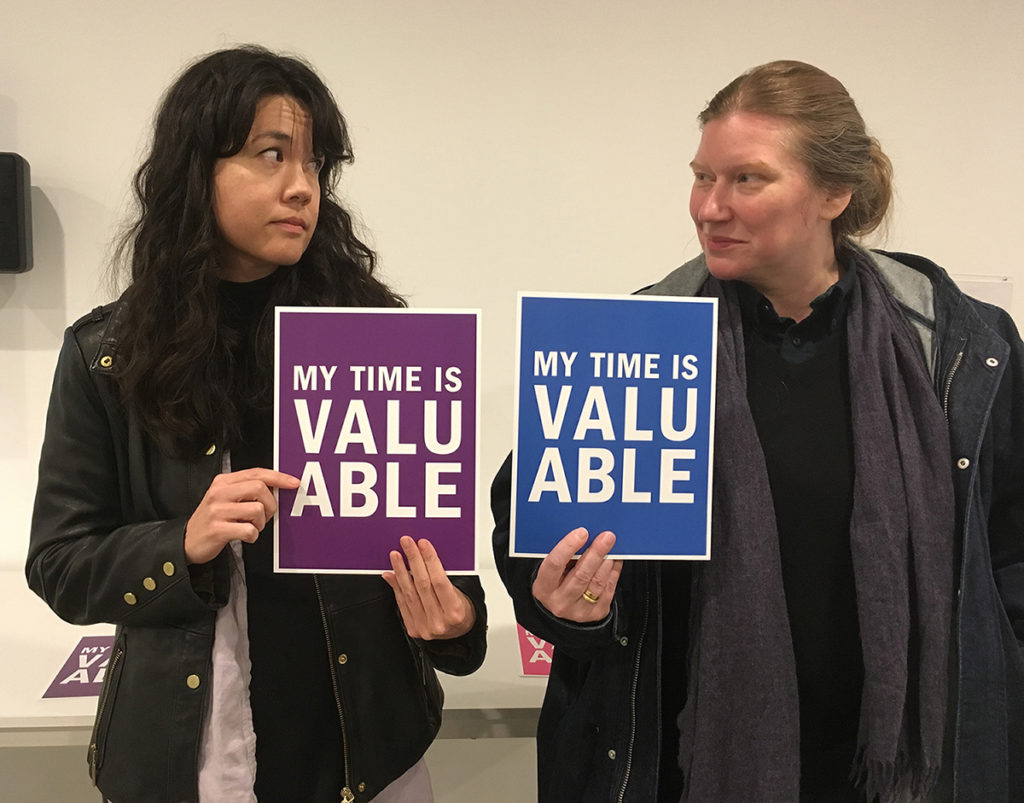
Jody Servon, My Time is Valuable: Tara and Jeanine, 2017. Los Angeles, CA. Photo Credit: Jody Servon
Jody Servon
1. Tell us about yourself and your project for AiOP BODY 2018:
My Time is Valuable is a participatory project for women, girls, non-binary and female identifying people to make visible the value of our time by spreading this critical message in our homes, our workplaces and beyond. Free prints with this language are distributed and participants are encouraged to make and share a photo of themselves with the print. My Time is Valuable is shared and spread in person, at select distribution sites, and through social media. These prints serve as reminders to ourselves and others that we are to be valued and treated equitably. Our message must be seen by everyone who we coexist with in this world as we cannot establish equality on our own.
2. What does the theme BODY mean to you?
The bodies we inhabit as women, girls, female identifying or non-binary people in our patriarchal society force us into certain identities that bring forth problematic perceptions, communications, judgments, biases and stereotypes. My Time is Valuable makes visible our advocacy for equality.
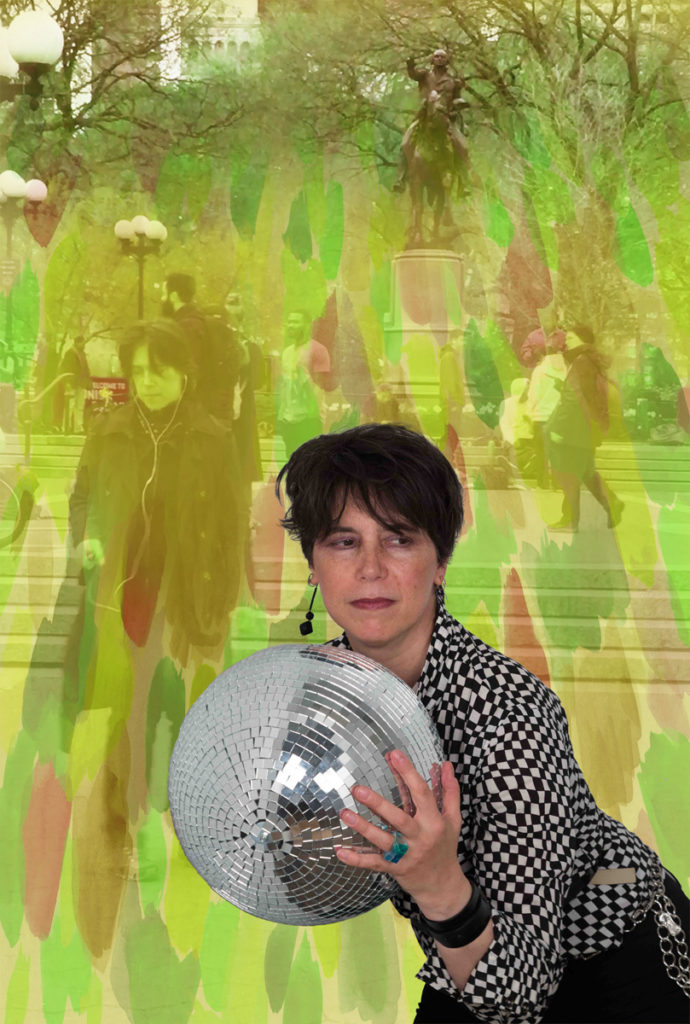
Elaine Angelopoulos, Dance Memoir, 2018. Photo Credit: Vince Ruvolo, Graphic Design: Elaine Angelopoulos
Elaine Angelopoulos
1. Tell us about yourself and your project for AiOP BODY 2018:
Shake a leg with me!
Dance Memoir is a tribute free style dancing in New York City. Find my mobile music station with a disco ball along various points on 14th Street. I’ll groove to my playlist of tunes from the disco, punk, hip-hop, and rock era as I invite you for a moment of dance and conversation. Tell me about NYC clubs times passed or how dance changed your life and body image.
My wall installation shall illuminate a club like atmosphere. Works on paper with vibrant colors composed into a dynamic grid will be shown along with select ephemera, a video piece, and a musical playlist. Excerpts from exchanges will be added onto the wall in-between dance sessions during the festival.
My interdisciplinary approach bridges studio practices with audience participation, within installations and performances. My work has been exhibited in New York, the United States, and in Europe. In 2014, I became a Jerome Fellow through the Franklin Furnace Fund for my ongoing performance works.
2. What does the theme BODY mean to you?
Dance is a self-expression of the body that conveys freedom, where people unfold from their daily life. A blend of cultures, identities, sexualities, classes and persons of color, fosters freedom, feminism, queerness, and bold directions as reconfigured bodies.

Catherine Feliz, Say It With Flowers, 2018
Catherine Feliz
1. Tell us about yourself and your project for AiOP BODY 2018:
I am an interdisciplinary artist, full spectrum doula, and community medicine-maker born and raised in NYC. Say It With Flowers examines the boundless commodification of flowers and feminized labor under late capitalism. Growing up in a Dominican immigrant household, I was always surrounded by visual reminders of abundant tropical landscapes: plastic flowers and patterned motifs. Like diasporic people, plants too are migrating under various pressures of control and desire placed on the land. Centering the emotional intelligence of women and femmes employed in health and service jobs, “Say It With Flowers” draws from archival images and public accounts to realign our perspectives of the care industry against a backdrop of corporate market exchanges. What are the plants and people hiding in plain sight communicating to us?
2. What does the theme BODY mean to you?
Body is our point of contact. it is sacred, it is messy. Body is land. Body is constrained earthly freedom. It’s a beautiful illusion. Body is an instrument for which I’m always learning new sounds.

Martha Hipley, ur best selfie, 2018. Image credit: Martha Hipley
Martha Hipley
1. Tell us about yourself and your project for AiOP BODY 2018:
ur best selfie is an iteration in a series of digital tools for reclaiming personal identity with creativity while also raising awareness of the dangers of face and location tracking software. This latest iteration is a web app that allows visitors to 14th street to have fun making fantastical selfies that are designed to defeat the current facial recognition algorithms used by most social media apps. The app also asks users to be wary of allowing websites and apps to track their location. Social media and selfie filters can be fun, but they also have real consequences. The project attempts to find a positive middle ground between total abstinence from technology and dangerous overuse.
2. What does the theme BODY mean to you?
The digital world once felt like a place where I could be free of my body, but the commercialization of the internet has led to new ways for bodies to be vulnerable and violated. Our likenesses and behaviors are used to train systems to be more efficient for violating others’ bodies as well.
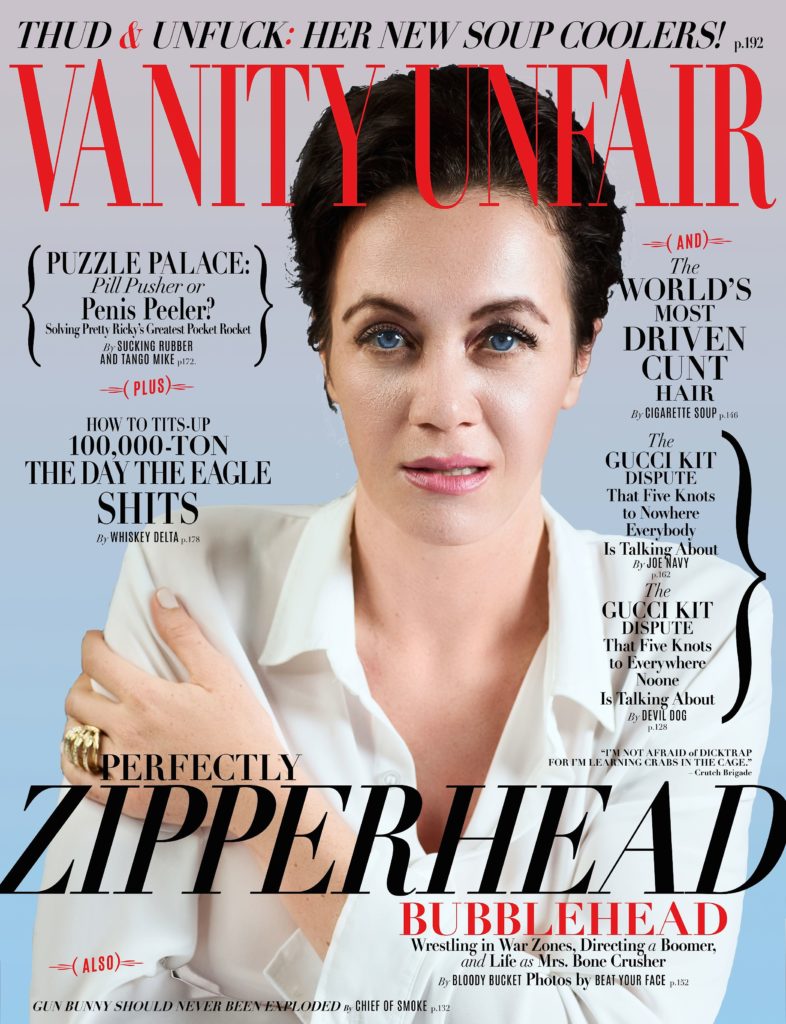
Nadja Verena Marcin, Cover Girls, 2017. Courtesy of the artist, AKArt, San Francisco and 532 Thomas Jaeckel Gallery, New York.
Nadja Verena Marcin
1. Tell us about yourself and your project for AiOP BODY 2018:
Cover Girls (2017) reveals the animosity of women’s representation in commercial fashion and advertisement, commenting on how said avatars are unreal, digitally manipulated ideals, designed to display a seamless appearance to keep women in conflict with their own imperfect bodies.
When first performed, I enacted four doubles of different Cover Girls, staging the models as interchangeable. Spiked with unlikely headlines from military slang as “Latrine Queen”, an Air Force term for a trainee who is in charge of cleaning bathrooms, or “Oxygen Thief”, a slang term for someone who is useless, the avatar’s power is turning against itself – making visible the warfare on women’s bodies.
The posters of Cover Girls will be wild posted on public spots such as boards, construction fences and graffiti walls in proximity to 14th Street in Manhattan. Additionally, the Cover Girls will be placed as a casual magazine in coffee shops and doctors offices, although its pages include a military dictionary.
2. What does the theme BODY mean to you?
The separation of body and mind is Western control ideology, which fails inside the practical. Women’s bodies are surfaced for trade and commerce without prior consent. This long-standing depreciation is a crime to womanhood, to resist I inspect souls and design psychological awakening.

